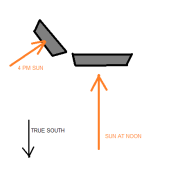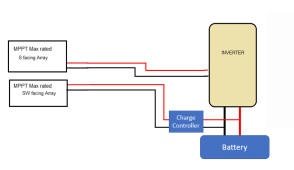SolarHead
50% of people are below average. (Its a statistic)
Here's a thought I've had but wondered if there's another way to do this and get same (or better) results.
Say my inverter MPPT's are maxed out with what they are rated for voltage/amp wise and I cannot add more panels to my south-facing array as a result.
I have a battery bank but don't want to buy more batteries, but was wondering how get more usable power say in the afternoons from 4pm to 7pm to 8pm , I mean the inverter is there that I paid for, and it can do more work the day isn't over with yet. I see the sun going toward that angle and my incoming power starting to drop as the sun drops.
What if I had another array aimed say SouthWest direction, and have an automated timer/switch of some sort that would turn the south-facing array OFF, and the SW facing array ON? Something like the drawing below. Install some type of timer/switch outside mounted under the array, (or inside the home) , that knows at 4pm to turn OFF one array and turn ON the other array. That would be so my inverters MPPT's wouldn't get overloaded. Basically it would be a tracker but built with solar panel arrays and switches. I know what most people will say, that you point all panels due south and that's the most power. I get that. But what if I want to stretch the curve and have more even power generated throughout the day, is there any merit or need for this? I guess if all panels aimed due south would produce more power, then I'd need to do either ONE - use the power as it comes in, or TWO - store the power and have enough battery bank to store it all. I was thinking having 2 different arrays aimed at different directions and have one array turn on when the other turns off, you could "follow" the sun through the day and get more usable power that isn't necessarily stored in batteries. Either this is a good idea, or terrible one.
I had thought about AC coupling a 2an array but would have to buy a string inverter in order to AC couple. That would fatten the production curve if I aimed those panels southwest (for example). It may be cheaper to NOT buy another string inverter, NOT buy the more panels, just stick with my existing array and get more battery (but then again, more battery is $$$). I was thinking maybe an inexpensive string inverter or even use microinverters on the 2nd array and bring that AC power into my inverter via AC coupling. Either way, I was thinking garner that afternoon sun and stay off my batteries a bit more from say 4 to 7pm, lessening the need for investing in more battery bank.

Some type of DC timer/switch/combiner box, dont know if something like this exists but sure it could be made.

Say my inverter MPPT's are maxed out with what they are rated for voltage/amp wise and I cannot add more panels to my south-facing array as a result.
I have a battery bank but don't want to buy more batteries, but was wondering how get more usable power say in the afternoons from 4pm to 7pm to 8pm , I mean the inverter is there that I paid for, and it can do more work the day isn't over with yet. I see the sun going toward that angle and my incoming power starting to drop as the sun drops.
What if I had another array aimed say SouthWest direction, and have an automated timer/switch of some sort that would turn the south-facing array OFF, and the SW facing array ON? Something like the drawing below. Install some type of timer/switch outside mounted under the array, (or inside the home) , that knows at 4pm to turn OFF one array and turn ON the other array. That would be so my inverters MPPT's wouldn't get overloaded. Basically it would be a tracker but built with solar panel arrays and switches. I know what most people will say, that you point all panels due south and that's the most power. I get that. But what if I want to stretch the curve and have more even power generated throughout the day, is there any merit or need for this? I guess if all panels aimed due south would produce more power, then I'd need to do either ONE - use the power as it comes in, or TWO - store the power and have enough battery bank to store it all. I was thinking having 2 different arrays aimed at different directions and have one array turn on when the other turns off, you could "follow" the sun through the day and get more usable power that isn't necessarily stored in batteries. Either this is a good idea, or terrible one.
I had thought about AC coupling a 2an array but would have to buy a string inverter in order to AC couple. That would fatten the production curve if I aimed those panels southwest (for example). It may be cheaper to NOT buy another string inverter, NOT buy the more panels, just stick with my existing array and get more battery (but then again, more battery is $$$). I was thinking maybe an inexpensive string inverter or even use microinverters on the 2nd array and bring that AC power into my inverter via AC coupling. Either way, I was thinking garner that afternoon sun and stay off my batteries a bit more from say 4 to 7pm, lessening the need for investing in more battery bank.

Some type of DC timer/switch/combiner box, dont know if something like this exists but sure it could be made.






